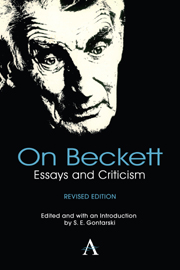Book contents
- Frontmatter
- Contents
- The Essential Beckett: A Preface to the Second Edition
- A Beckett Chronology
- Acknowledgments
- Crritics and Crriticism: “Getting Known”
- Preliminaries
- The Page
- Murphy and the Uses of Repetition
- Watt
- Mercier and Camier: Narration, Dante, and the Couple
- Molloy's Silence
- Where Now? Who Now?
- The Voice and Its Words: How It Is
- The Unnamable's First Voice?
- Between Verse and Prose: Beckett and the New Poetry
- Worstward Ho
- The Stage
- Coda
- Notes on Contributors
The Voice and Its Words: How It Is
from The Page
Published online by Cambridge University Press: 05 May 2013
- Frontmatter
- Contents
- The Essential Beckett: A Preface to the Second Edition
- A Beckett Chronology
- Acknowledgments
- Crritics and Crriticism: “Getting Known”
- Preliminaries
- The Page
- Murphy and the Uses of Repetition
- Watt
- Mercier and Camier: Narration, Dante, and the Couple
- Molloy's Silence
- Where Now? Who Now?
- The Voice and Its Words: How It Is
- The Unnamable's First Voice?
- Between Verse and Prose: Beckett and the New Poetry
- Worstward Ho
- The Stage
- Coda
- Notes on Contributors
Summary
In discussing Beckett's works it is frequently useful to divide his career into three segments: the early period of exploration in English extending from pieces like “Assumption” and “A Case in a Thousand” to Watt (up to 1944), the middle period of French prose and the narrator-narrated beginning with Mercier and Camier and including How It Is (1946–60), and the later period of the enigmatic short pieces from “Imagination Dead Imagine” through the present (1965–). Useful as it otherwise may be, however, a tripartite division of the Beckettian canon obscures an important shift in the conceptual framework of Beckett's pieces. How It Is does not present simply a continuation of the techniques and themes developed in the trilogy. Instead the book marks a turning point in Samuel Beckett's career from an exploration of the limitations of the human mind and an emphasis upon definitions of the self, to an identification of the self with the voice and an acceptance, if not a celebration, of the life of the imagination. Indeed, How It Is enables Beckett to surmount the attitude of disintegration L'Innommable once caused in him by directing attention not to the divorce of the mind from the external world, but rather to the internal worlds the mind creates.
- Type
- Chapter
- Information
- On BeckettEssays and Criticism, pp. 118 - 132Publisher: Anthem PressPrint publication year: 2012

